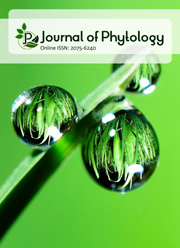Diversity of fungal endophytes at different maturity levels of Cryptolepis buchanani leaves
DOI:
https://doi.org/10.25081/cb.2023.v14.7210Keywords:
Fungal endophytes, Cryptolepis buchanani, Medicinal plant, Leaf diversityAbstract
A study on endophytic microflora diversity at each level and portion of the leaves of Cryptolepis buchanani, a medicinal plant used by tribals of Madhya Pradesh, India was carried out in the present investigation. As many as 383 isolates from 360 discs of leaves belonging to 17 fungal species and 9 isolates, which did not show any sporulation (sterile), were recovered. Among the 17 identified species, hyphomycetes is the dominant class and Aspergillus, Colletotrichum and Khuskia are the dominant genera. Colonization frequency (CF) was higher in mature leaves (78.3%) and comparatively lower in younger leaves (51.1%) and there was a marginal decrease in CF from the base of the leaf (66.7%) towards the leaf apex (62%). Statistical analysis revealed that level of the leaf had a significant effect on CF and diversity of fungal endophytes, while as leaf sub-parts had little influence. Biochemical characterization of the endophyte revealed the production of various enzymes viz. protease, amylase, lipase, cellulase, xylanase and pectinase. These fungal enzymes can be tapped for food, pharma, beverages, textiles, confectionaries, and leather industries. These bioactive natural products are easy to process as they are usually more stable than products obtained from other sources. The enzymatic activities also help to get a better insight into the host-endophyte relationship. However, the world of fungal endophytes needs to be researched extensively for production of plant based novel eco-friendly biomolecules in cost-effective manner.
Downloads
References
Arnold, A. E. (2005). Diversity and ecology of fungal endophytes in tropical forests. In D. Deshmukh (Ed.), Current Trends in Mycological Research (pp. 49-68) New Delhi, India: Oxford and IBH Publishing Co. Pvt. Ltd.
Arnold, A. E., Mejía, L. C., Kyllo, D., Rojas, E. I., Maynard, Z., Robbins, N., & Herre, E. A. (2003). Fungal endophytes limit pathogen damage in a tropical tree. Proceedings of the National Academy of Sciences, 100(26), 15649-15654. https://doi.org/10.1073/pnas.2533483100
Bacon, C. W., & White, J. (2000). Microbial Endophytes. (1st ed.). Boca Raton, US: CRC Press. https://doi.org/10.1201/9781482277302
Card, S., Johnson, L., Teasdale, S., & Caradus, J. (2016). Deciphering endophbehavioriour: the link between endophyte biology and efficacious biological control agents. FEMS Microbiology Ecology, 92(8), fiw114. https://doi.org/10.1093/femsec/fiw114
Carroll, F. E., Muller, E., & Sutton, B. C. (1977). Preliminary studies on the incidence of needle endophytes in some European conifers. Sydowia, 29(87), 87-103.
Carroll, G. C., & Carroll, F. E. (1978). Studies on the incidence of coniferous needle endophytes in the Pacific Northwest. Canadian Journal of Botany, 56(24), 3034-3043. https://doi.org/10.1139/b78-367
Chen, L., Zhang, Q.-Y., Jia, M., Ming, Q.-L., Yue, W., Rahman, K., Qin, L.-P., & Han, T. (2016). Endophytic fungi with antitumor activities: Their occurrence and anticancer compounds. Critical Reviews in Microbiology, 42(3), 454-473. https://doi.org/10.3109/1040841X.2014.959892
Collinge, D. B., Jensen, D. F., Rabiey, M., Sarrocco, S., Shaw, M. W., & Shaw, R. H. (2022). Biological control of plant diseases- what has been achieved and what is the direction? Plant Pathology, 71(5), 1021-1228. https://doi.org/10.1111/ppa.13555
Hamayun, M., Khan, S. A., Ahmad, N., Tang, D.-S., Kang, S.-M., Na, C.-I., Sohn, E.-Y., Hwang, Y.-H., Shin, D.-H., Lee, B.-H., Kim. J.-G., & Lee, I.-J. (2009). Cladosporium sphaerospermum as a new plant growth-promoting endophyte from the roots of Glycine max (L.) Merr. World Journal of Microbiology and Biotechnology, 25(4), 627-632. https://doi.org/10.1007/s11274-009-9982-9
Hammer, O., Harper, D. A. T., & Ryan, P. D. (2001). PAST: Paleontological statistics software package for education and data analysis. Palaeontologia Electronica, 4(1), 9.
Hanprasertpong, N., Teekachunhatean, S., Chaiwongsa, R., Ongchai, S., Kunanusorn, P., Sangdee, C., Panthong, A., Bunteang, S., Nathasaen, N., & Reutrakul, V. (2014). Analgesic, anti-inflammatory, and chondroprotective activities of Cryptolepis buchanani extract: in vitro and in vivo studies. BioMed Research International, 2014, 978582. https://doi.org/10.1155/2014/978582
Hardoim, P. R., Van Overbeek, L. S., Berg, G., Pirttilä, A. M., Compant, S., Campisano, A., Döring, M., & Sessitsch, A. (2015). The hidden world within plants: ecological and evolutionary considerations for defining functioning of microbial endophytes. Microbiology and Molecular Biology Reviews, 79(3), 293-320. https://doi.org/10.1128/MMBR.00050-14
Kaul, A., Bani, S., Zutshi, U., Suri, K. A., Satti, N. K., & Suri, O. P. (2003). Immunopotentiating properties of Cryptolepis buchanani root extract. Phytotherapy Research: An International Journal Devoted to Pharmacological and Toxicological Evaluation of Natural Product Derivatives, 17(10), 1140-1144. https://doi.org/10.1002/ptr.1186
Khan, A. L., Hussain, J., Al-Harrasi, A., Al-Rawahi, A., & Lee, I.-J. (2015). Endophytic fungi: resource of gibberellins and crop abiotic stress resistance. Critical Reviews in Biotechnology, 35(1), 62-74. https://doi.org/10.3109/07388551.2013.800018
Khare, M. P., & Shah, B. B. (1983). Structure of buchanin, a new cardenolide from Cryptolepis buchanani Roem. & Schult. Journal of Nepal Chemical Society, 3, 21-30.
Latz, M. A. C., Jensen, B., Collinge, D. B., & Jorgensen, H. J. K. (2020) Identification of two endophytic fungi that control Septoria tritici blotch in the field, using a structured screening approach. Biological Control, 141, 104128. https://doi.org/10.1016/j.biocontrol.2019.104128
Lozupone, C. A., & Knight, R. (2008). Species divergence and the measurement of microbial diversity. FEMS Microbiology Reviews, 32(4), 557-578. https://doi.org/10.1111/j.1574-6976.2008.00111.x
Malinowski, D. P., & Belesky, D. P. (2000). Adaptations of endophyte-infected cool-season grasses to environmental stresses: mechanisms of drought and mineral stress tolerance. Crop Science, 40(4), 923-940. https://doi.org/10.2135/cropsci2000.404923x
Manasa, K. M., Vasanthakumari, M. M., Nataraja, K. N., & Uma Shaanker, R. (2020). Endophytic fungi of salt adapted Ipomea pes-caprae L. R. Br: their possible role in inducing salinity tolerance in paddy (Oryza sativa L.). Current Science, 118(9), 1448-1453.
Okane, I., Nakagiri, A., & Ito, T. (1998). Endophytic fungi in leaves of ericaceous plants. Canadian Journal of Botany, 76(4), 657-663. https://doi.org/10.1139/b98-032
Owen, N. L., & Hundley, N. (2004). Endophytes — the chemical synthesizers inside plants. Science Progress, 87(2), 79-99. https://doi.org/10.3184/003685004783238553
Padmalochana, K., Dhana Rajan, M. S., Lalitha, R., & Sivasankari, H. (2013). Evaluation of the antioxidant and hepatoprotective activity of Cryptolepis buchanani. Journal of Applied Pharmaceutical Science, 3(2), 99-104.
Pande, M., Dubey, V. K., Yadav, S. C., & Jagannadham, M. V. (2006). A novel serine protease cryptolepain from Cryptolepis buchanani: purification and biochemical characterization. Journal of Agricultural and Food Chemistry, 54(26), 10141-10150. https://doi.org/10.1021/jf062206a
Panthong, A., Kanjanapothi, D., & Taylor, W. C. (1986). Ethnobotanical review of medicinal plants from Thai traditional books, Part I: Plants with anti-inflammatory, anti-asthmatic and antihypertensive properties. Journal of Ethnopharmacology, 18(3), 213-228. https://doi.org/10.1016/0378-8741(86)90001-2
Paulo, A., & Houghton, P. J. (2003). Chemotaxonomic analysis of the genus Cryptolepis. Biochemical Systematics and Ecology, 31(2), 155-166. https://doi.org/10.1016/S0305-1978(02)00075-3
Purushothaman, K. K., Vasanth, S., Connolly, J. D., & Rycroft, D. S. (1988). New sarverogenin and isosarverogenin glycosides from Cryptolepis buchanani (Asclepiadaceae). Revista Latinoamericana de Quimica, 19(1), 28-31.
Rho, H., Hsieh, M., Kandel, S. L., Cantillo, J., Doty, S. L., & Kim, S.-H. (2018). Do endophytes promote growth of host plants under stress? A meta-analysis on plant stress mitigation by endophytes. Microbial Ecology, 75, 407-418. https://doi.org/10.1007/s00248-017-1054-3
Rodrigues, K. F., Leuchtmann, A., & Petrini, O. (1993). Endophytic species of Xylaria: cultural and isozymic studies. Sydowia, 45(1), 116-138.
Rubina, B. (2009). Bioprospecting for endophytes from Stevia rebaudiana Bertoni. Leaves. Doctoral Dissertation, Barkatullah University.
Sampangi-Ramaiah, M. H., Jagadheesh, Dey, P., Jambagi, S., Vasantha Kumari, M. M., Oelmüller, R., Nataraja, K. N., Ravishankar, K. V., Ravikanth, G., & Uma Shaanker, K. (2020). An endophyte from salt-adapted Pokkali rice confers salt-tolerance to a salt sensitive rice variety and targets a unique pattern of genes in its new host. Scientific Reports, 10, 3237. https://doi.org/10.1038/s41598-020-59998-x
Schulz, B., & Boyle, C. (2005). The endophytic continuum. Mycological Research, 109(6), 661-686. https://doi.org/10.1017/S095375620500273X
Stone, J. K. (1987). Initiation and development of latent infections by Rhabdocline parkeri on Douglas-fir. Canadian Journal of Botany, 65(12), 2614-2621. https://doi.org/10.1139/b87-352
Strobel, G., & Daisy, B. (2003). Bioprospecting for microbial endophytes and their natural products. Microbiology and Molecular Biology Reviews, 67(4), 491-502. https://doi.org/10.1128/MMBR.67.4.491-502.2003
Sunil, K., Batuk, D., Sharma, N., & Sharria, P. V. (1980). A new nicotinoyl glucoside from Cryptolepis buchanani. Phytochemistry, 19(6), 1278. https://doi.org/10.1016/0031-9422(80)83117-7
Suryanarayanan, T. S., & Vijaykrishna, D. (2001). Fungal endophytes of aerial roots of Ficus benghalensis. Fungal Diversity, 8, 155-161.
Tan, R. X., & Zou, W. X. (2001). Endophytes: a rich source of functional metabolites. Natural Product Reports, 18(4), 448-459. https://doi.org/10.1039/b100918o
Taylor, J. E., Hyde, K. D., & Jones, E. B. G. (1999). Endophytic fungi associated with the temperate palm, Trachycarpus fortunei, within and outside its natural geographic range. New Phytologist, 142(2), 335-346. https://doi.org/10.1046/j.1469-8137.1999.00391.x
Venkateswara, R., Narendra, N., Viswamitra, M. A., & Vaidyanathan, C. S. (1989). Cryptosin, a cardenolide from the leaves of Cryptolepis buchanani. Phytochemistry, 28(4), 1203-1205. https://doi.org/10.1016/0031-9422(89)80209-2
Wang, Y., Zeng, Q. G., Zhang, Z. B., Yan, R. M., Wang, L. Y., & Zhu, D. (2011). Isolation and characterization of endophytic huperzine A-producing fungi from Huperzia serrata. Journal of Industrial Microbiology and Biotechnology, 38(9), 1267-1278. https://doi.org/10.1007/s10295-010-0905-4
Waqas, M., Khan, A. L., Kamran, M., Hamayun, M., Kang, S.-M., Kim, Y.-H., & Lee, I.-J. (2012). Endophytic fungi produce gibberellins and indoleacetic acid and promotes host-plant growth during stress. Molecules, 17(9), 10754-10773. https://doi.org/10.3390/molecules170910754
Wu, L., Han, T., Li, W., Jia, M., Xue, L., Rahman, K., & Qin, L. (2013). Geographic and tissue influences on endophytic fungal communities of Taxus chinensis var. mairei in China. Current Microbiology, 66, 40-48. https://doi.org/10.1007/s00284-012-0235-z
Published
How to Cite
Issue
Section
Copyright (c) 2023 Sujata Bhardwaj, N. S. Abbas, Babeeta C Kaula, Anil Prakash

This work is licensed under a Creative Commons Attribution-NonCommercial 3.0 Unported License.



 .
.